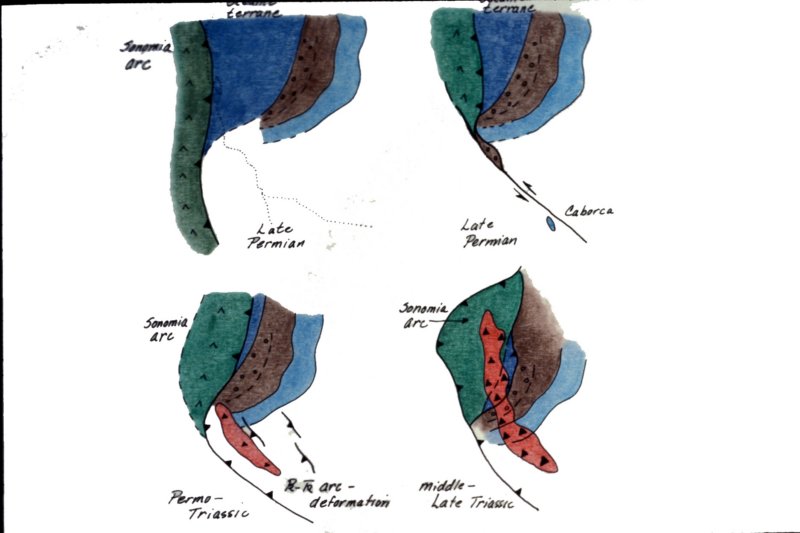

We begin this lecture at the end Paleozoic. Up to now, the tectonic assemblage of western North America has been dominated by the accretion of terranes over the passive margin. After the period of passive margin sedimentation, the Antler material overthurst the margin, then the Havallah (with a small island arc) overthurst the Antler, then finally the Sonoma Terrane overthurst the Havallah. These events were broadly experienced across the edge of western North America as we find remnants of the tectonic events from southern California to Alaska. -------------------- At the southern end of this continental margin we recognize that this sequence may have been truncated by what we believe to have been a large left lateral transform fault that offset the southern extension of the continental margin sequence into the region near Caborca, Mexico. Though the sequence is poorly exposed due to extensive cover beds of Cenozoic volcanics, there are exposures of rocks like those found in the western US. ---------------------- This truncation fault is important because it exposed the region the southeastern corner of the US as a continental margin. This continental margin was very different compared to the margin further north where the Passive Margin, Antler, Havallah and Sonoma materials bordered, covered and insulated the continental basement of North America. In the area where the truncation happened, the continental basement was directly exposed at the new raw margin and also was not covered by thick sequences of sediment. At this time, the continental margin also began to switch from a ‘West-Pacific’ style margin (where the tectonics are dominated by irregular collisions of island arcs and continental fragments) to an ‘Andean’ style margin (where the tectonics are dominated by steady subduction of oceanic crust beneath continental curst resulting in arc volcanism and accretionary wedges). --------------------- Most of the subduction that was happening during the time of the ‘West-Pacific’ style margin was west dipping so there was no arc plutonism along the edge of North America. After the Sonoma Orogeny, the Andean-style margin was all east-dipping subduction. As the subducting oceanic plate sinks under the edge of North America, temperatures and pressures increase and the slab experiences dehydration melting. This melting produces buoyant blobs of magma that rise through the mantle and impinge on the bottom of the continental crust. These hot, buoyant magmas penetrate the crust creating igneous intrusions that sometimes reach the surface forming extrusive volcanics. -------------------- The region northeast of the truncation was the first location to have this arc plutonism active (red area on image) (in the late Permian). Arc plutonism/volcanism then swept sequentially northward as the Andean-style subduction margin was gradually established along the western edge of North America. By the Middle Triassic, the Arc was active along the entire margin. In the Mojave region in southwest NA, where there is thick Precambrian crust, the styles of intrusion and compressional deformation along the subduction margin are totally different and much more complicated than those further to the north where the intrusions were coming up through the passive margin sediments and the accreted terranes.
Created with Web Album Generator